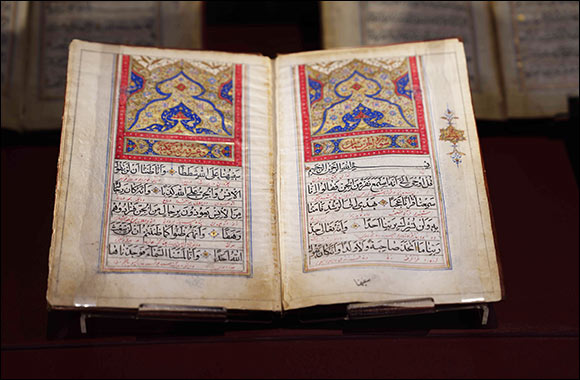
Dubai, UAE, 17 May 2024: On International Museum Day, museums in the UAE stand out to paint a unique picture of human history that reflects the diversity and cultural heritage of Arab and human civilization. They represent a bridge between the past and the present, through a wide range of archaeological and artistic collections that tell the stories of peoples and civilizations. At the heart of the Mohammed Bin Rashid Library, the Treasures of the Library Exhibition boasts more than 300 rare books, atlases, and ancient manuscripts, some of which date back to the 13th century. The exhibition reflects the vital role of museums in preserving cultural heritage and transmitting it to future generations. With its unique design and precious contents, it offers an enjoyable educational experience that aligns with the goals of International Museum Day, to be a gateway to cultural and intellectual communication between different peoples and civilizations. Old Original Books Additionally, the Treasures of the Library exhibits the complete works of William Shakespeare, the most celebrated English playwright and one of the greatest writers worldwide. This includes the first edition of Shakespeare's edited works, including 36 of his plays, which were originally printed in London in 1632, “Shahnameh”, the popular Persian poem, The Divine Comedy of Dante, one of the pillars of Italian literature, and the novel “Les Misérables” by Victor Hugo, which tells stories of struggle and injustice. This valuable collection reflects the role of the Mohammed Bin Rashid Library in preserving the human heritage and literary and cultural treasures and sharing them generation after generation, in line with its vision to promote the cultural and literary field. Rare Copies of the Holy Quran The exhibition boasts 40 rare copies of the Holy Quran, and approximately 40 rare Quranic pieces, both manuscript and printed, including the oldest examples of parchment written on leather, the most beautiful handwritten Quran manuscripts, in addition to a group of the first translations of the Holy Quran printed in different languages and their first editions. These translations are distinguished by their unique designs and advanced writing techniques. They also reflect the ingenuity of the calligraphers who wrote the texts in exquisite and ornate fonts, making each Quraan a unique piece of art. Many Quraanic patches made of leather, which are among the oldest pieces and represent the beginning of Islam and the writing of the Holy Quraan, are characterised by simple, unadorned writing, as calligraphers used the Kufic script to write these patches. Then the types of fonts and decorations used developed, and they began integrating colors and gold in writing on patches. Among these copies is a Quran from the Qajar era, written in Naskh script, 15 lines per page, copied by Muhammad Shafi’ bin Ali Askar al-Arsanjani, and decorated and embellished by the artist Reza Sani Humayun. In addition, the collection also includes a Quran from the Mughal era in India, which dates back to the 11th century, written in Naskh script with multi-coloured panels. The exhibition also includes a large Quran from the Ottoman era, written in cursive Naskh script. The front of the Quraan was decorated on both sides with floral designs surrounding Surat Al-Fatihah and the beginning of Surat Al-Baqarah, and around it were leafy, multi-colored decorations and gilded frames and edges. Atlases and Volumes The exhibition features the first prints of various books on journeys to the Arabian Peninsula and descriptions of the Middle East, as well as a highly valuable collection of European and Ottoman maps of the Arabian Peninsula between 15th-19th centuries, including a coloured and gilded Ptolemy map printed in 1482. A key rare document in the Exhibition is Frederik de Wit’s the composite Atlas Maior, printed in Amsterdam, the Netherlands between 1680-1686. Bringing together various maps from the Dutch Golden Age, the Atlas with its vibrant colours depicts that era of prosperous arts, sciences, and exploration across the worlds of land and sea. This version of the Atlas was also the last to be published by Joan Blaeu. Writing Tools Among the rare collectibles found in the exhibition is a collection of writing tools that were used throughout the ages, including knives and pencil nippers from the Ottoman and Seljuk era, in addition to inkwells and pencil cases dating back to various time periods. Among the rare pieces are metal inkwells inlaid with silver and copper from the Seljuk era, antique inkwells from the Byzantine era, and a gold pencil case inlaid with precious stones from the Deccan Sultanates. Writing tools are evidence of the craftsmanship and advanced techniques used by calligraphers throughout history. For example, pen knives were made with precision to allow calligraphers to shape and maintain reed and bamboo pens, the basic tools for writing manuscripts. Inks and pencil cases were also made of various materials, such as silver, copper, and gold, to reflect the artistic and intellectual richness of the eras to which they belong, adding a new dimension to our understanding of the history of writing and Arabic calligraphy. The Treasures of the Library Exhibition aims to stimulate passion for knowledge, preserve cultural heritage, and promote an in-depth understanding of human history and culture by displaying valuable collections. The exhibition also aims to build a bridge between the past and the present to encourage visitors to explore previous eras and understand the development of humanity. The exhibition contributes to fostering interaction between the public and historical collections, by organising periodic exhibitions, cultural events, workshops, and lectures on various topics such as the art of Arabic calligraphy, writing and decoration techniques, and the history of manuscripts. This allows visitors to interact with experts and specialists, which enriches their experience and deepens their understanding of history and culture.
|